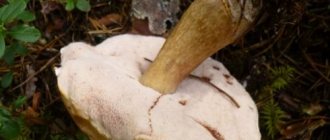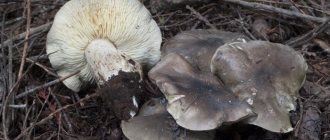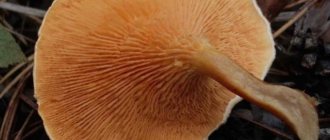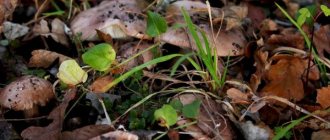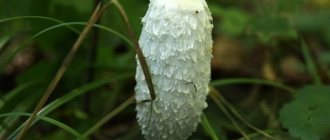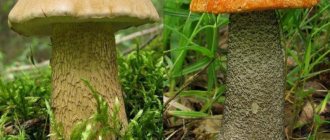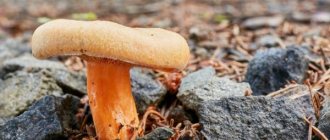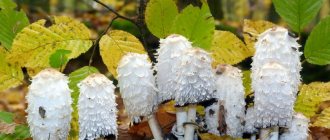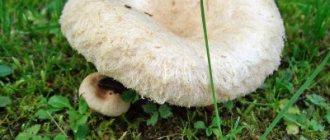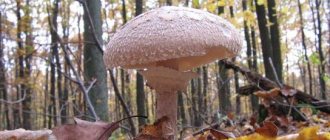Quite often, inexperienced mushroom pickers confuse the white (edible) mushroom with mustard - a false white mushroom (inedible). Externally, the two representatives of the Boletaceae family have a number of similarities, so it is quite possible to confuse them. And only in the process of preparing or consuming a dish will a person be able to identify an error during collection and feel the characteristic bitterness. False porcini mushroom should never be used in cooking. In medicine, bittersweet is used as a choleretic agent.
Description of the mushroom
Gorchak belongs to the Boletaceae family. It bears fruit from late June to mid-October, but may end the growing season in September with the onset of early frosts. The most active development of the mushrooms in question is observed in the warm period after heavy rain.
What does it look like
Description of the characteristic features of bitterling:
| Height |
|
| Hat shape and size |
|
| Hymenophore (mushroom flesh on the inside of the cap) |
|
| Outside color of the cap |
|
| Leg |
|
| Pulp |
|
Where does it grow
The representative of the fungal kingdom in question is distributed everywhere. Settles mainly in coniferous forests. Most often, mushroom glades of bitterlings are found next to swampy areas, mosses, and rotten fallen trees . Bitterweeds grow in small groups or singly. On fallen rotten trees, mushrooms form whole clusters.
Important! If even one bitter mushroom is cooked with other edible mushrooms, the taste of the dish will inevitably be spoiled: it will acquire an unpleasant bitterness.
Edible or not
Gorchak is an inedible mushroom, but it is not poisonous . It is not eaten for food only because of its unpleasant taste. However, if you carry out high-quality pre-processing, the product may well diversify your diet, adding interesting notes to your favorite dishes.
Growing
There are three ways to grow bitterlings at home.
In the garden
To do this, you need to purchase ready-made mycelium in a specialized store or prepare planting material yourself from freshly picked mushrooms.
Take the caps of the fruiting bodies (8-10 pieces), separate them from the stems, fill them with water and leave them to infuse for a day. The next day, knead them with your hands into a paste (you can rub them through a fine sieve), and mix the mushroom solution thoroughly.
In the garden, select a suitable place near birch, pine or oak trees, where bitters usually grow in nature - near the trees with which they form mycorrhizae. Remove the top layer of soil up to 20-25-30 cm thick. Purchased or homemade mycelium is mixed with a pre-prepared substrate, which includes straw, deciduous tree bark or compost.
Lay it in a thick layer - 4-5 cm, sprinkle it with garden soil on top and water it.
Further care consists of periodically moistening the soil and, if necessary, sheltering from sunlight to avoid drying out of the mycelium.
The bed is insulated for the winter a month before the onset of cold weather - fallen leaves or sawdust are used.
If everything is done correctly, you will receive the first harvest next year in July. The lifespan of the mycelium directly depends on the lifespan of the tree chosen for its planting.
In room
You can grow bitters not only outdoors, but also indoors - a barn or basement.
To do this, it is necessary to provide certain growth conditions:
- stable temperature within 20-21°C;
- humidity at 70-75%;
- good ventilation;
- daylight.
How to salt bitters so that they turn out not only edible, but also tasty is a question that interests many housewives. Due to their bitter taste, these mushrooms are not very common in cooking, but if cooked correctly, they turn out very appetizing.
Varieties and lookalikes
According to their characteristics, bitterlings are similar in appearance to a large number of tubular specimens:
- white or boletus;
- greenfinch;
- boletus;
- champignon;
- loading;
- honey fungus;
- poisonous satanic mushroom.
Did you know? Fungi reproduce by spores. The record holder for the number of spores emitted is a raincoat - it spreads more than 7 trillion of these microparticles to a height above 2 m at a speed of 90 km/h.
The main feature that distinguishes bitterlings from their edible counterparts is the mesh on the stalk . Boletus, boletus, champignon and milk mushrooms have scales on their stems. The first grows mainly in deciduous forests, while bitterlings prefer coniferous forests. If we talk about greenfinches, they do not grow on the surface of the soil, but are hidden under its cover, at a depth of about 3 cm. Honey mushrooms are distinguished by smaller dimensions, a thin light brown leg smooth around the entire perimeter and a flat cap of a darker color. The satanic mushroom is distinguished by a thick stem, which is colored pink, while the bitter one is pale.
farmland thunderstorm
Farmers are sounding the alarm and believe that bitterling can pose a threat not only to food security, but also to environmental security. It is very difficult to fight it, so task No. 1 is to prevent its appearance and spread. One of the ways bittergrass contaminates the soil is when its seeds get in with the seeds of cultivated plants, so it is important to sow the soil with clean material. For this purpose, Rosselkhoznadzor specialists, as part of phytosanitary control, check grain and seeds transported and imported into Russia for the presence of bittergrass seed.
However, preventive actions are not always sufficient, so new territories infested with this plant periodically appear. The detected outbreak must be localized, and subsequently the creeping mustard must be completely exterminated within its boundaries. There are different measures to combat it: agrotechnical, biological and chemical. These include plowing the soil and pruning the root system, as well as cultivating certain crops in the weedy area. Often you have to resort to the use of chemicals that are sprayed on the clogged area. However, the key to success is the comprehensive application of the above methods!
Use in cooking
If the product is processed correctly, it can be eaten. However, do not exceed the dosage of 100 g per day. In China, these mushrooms are used in dry form - whole or ground. They are added to first and second courses to enhance the taste. To eliminate bitterness, the product is pre-soaked in water for 2–3 days. The liquid is changed every 3-4 hours to prevent molding.
In France, in order to eliminate bitterness, the product is first boiled in milk. It is then crushed and added to various dishes
You should not cook false boletus with other mushrooms. It is used only separately, after pre-treatment. It is also not worth boiling bitters in water right away, since it is very difficult to wash off the dark coating later. In addition, cooking in water without first soaking or boiling in milk only increases the bitterness.
Cooking rules
Despite the bitter taste and not very high nutritional value, bitters are readily used in cooking - they are pickled, salted, fried and frozen for the winter.
Before preparing any dish, mushrooms must be properly processed to get rid of the pungent smell and tart taste.
After collection, the fruiting bodies are freed from forest debris, washed in clean water, most of the stem is cut off, leaving a small fragment 1 cm long under the cap.
Next, they are placed in a capacious container and filled with water. Soak for 3 days, changing the water at least twice (or better yet, do this at least 2-3 times a day). To prevent them from becoming moldy, you can add 1 tsp to the water. citric acid and 1 tbsp. l. salt. This long soaking will remove all the bitterness. Afterwards you can start preparing them.
Soaking for 3 days is usually used with the hot salting method. If a cold salting method is intended, then soaking should take place for at least 6 days. With any salting method, the water should be changed as often as possible during soaking.
There are many recipes with bitters, let's look at the most popular ones.
Recipe 1. Fried mushrooms with potatoes
Many gourmets believe that these components combine perfectly in one dish.
To prepare you will need:
- potatoes - 10 pcs.;
- mushrooms - 0.5 kg;
- black peppercorns - 5-6 pcs.;
- salt - to taste;
- spices (bay leaf, etc.) - optional;
- chopped greens (dill, parsley) - for serving.
First, soaked mushrooms need to be boiled. Pour water into a saucepan, add a couple of black peppercorns, salt, and other spices (optional). The mushroom mass is transferred to a metal bowl, brought to a boil, and simmered for half an hour over low heat to maintain their shape. During cooking, it is necessary to periodically remove the foam.
The boiled fruiting bodies are placed in a colander to get rid of excess liquid. Then peel the potatoes, cut them into cubes, and boil them in salted water.
You can make a delicious dish from bitters
Mushrooms are fried in vegetable oil until golden brown, boiled potatoes are added, salt and pepper are added, poured with 200 ml of sour cream, and put in the oven for 20 minutes at 180°C.
The dish is served in portions, sprinkled with chopped parsley or dill.
Recipe 2. Pickled mustards
Pickled bitters are a classic way to prepare these mushrooms. For 2 kg of young mushrooms you will need:
table salt - 2 tbsp. l.;
allspice peas - 5 pcs.;
cloves (buds) - 5 pcs.;
bay leaf - 4 pcs.;
The washed (soaked) mushrooms are placed in a saucepan, filled with water and all the ingredients of the marinade are added without vinegar.
Boil over medium heat until boiling, then pour in vinegar (take the amount of vinegar based on personal experience) and cook for another 20 minutes.
While cooking is happening, prepare the container - sterilize the jars along with the lids. Fill each container with mushrooms and marinade so that it completely covers them, roll up, wrap and leave to cool completely.
Irina Selyutina (Biologist):
Pickled bitters are a fairly popular dish in various regions of Russia. And its taste largely depends on the quality of the prepared marinade. There are several tricks that can give it new flavor notes:
- If you want a “forest” taste for mushrooms, add currant and cherry branches and leaves. By the way, they will change not only the taste, but even the color of the marinade.
- A sweetish marinade can be obtained by adding granulated sugar and cinnamon (cloves).
- For an acidic marinade, increase the original portion of vinegar or citric acid.
- Adding salt and bay leaves will give a salty taste.
- Pepper (red, allspice, black or chili) will add spiciness to the marinade.
Once cooled, store in a cool place. You can try this preparation in 3-4 weeks.
Recipe 3. Frozen mushrooms
Mushrooms soaked for 3 days are boiled in clean water for 7-10 minutes.
Then the water is drained and the mushrooms are filtered. Pour water again, add salt, black peppercorns and allspice.
After boiling, add the bitters and cook over low heat for half an hour, remembering to remove the foam with a slotted spoon or spoon. Place in a colander, allow the water to drain, cool completely and place portions into plastic bags or plastic containers. Sent to the freezer.
In the future, such a preparation can be used for making soups, filling for pies, salads, frying and stewing.
It is not necessary to defrost mushrooms before cooking.
Recipe 4. Salted mustards
To prepare a tasty and aromatic pickle you will need several ingredients:
- mushrooms - 2 kg;
- onions 1-2 heads per 0.5 liter container;
- coarse salt - 4 tbsp. l.;
- bay leaf - 1-2 pcs.;
- sunflower oil - 3-4 tbsp. l.
- black pepper - 8-9 pcs.;
- dried dill;
- garlic;
- cloves - 2-3 buds;
Clear fruit bodies from forest debris, separate small ones from large ones. It is better to marinate the first ones.
Place them in a saucepan, add water, and simmer over low heat for 10 minutes. Then drain in a colander; when the liquid has drained, return it to the metal container, fill it with water, and leave to soak for 12 hours.
After this time, strain, add new liquid, cook for 20 minutes, strain again. While the mushrooms are cooling, you can peel the garlic and cut the cloves into slices.
Sterilize pickling jars.
Sprinkle a thin layer of salt on the bottom of each sterile jar, add bay leaf and pepper. The mushrooms are placed with their stems up, each layer is sprinkled with salt, chopped dill (scalded with boiling water to make its smell softer) and garlic.
The top (last layer) is sprinkled with salt, then poured with boiling water and added 2 tbsp. l. vegetable oil in each jar. The blanks are rolled up with tin lids and, after cooling, taken out for storage in a cellar or basement.
Danger from the mushroom
If you eat a small amount of the product in question, poisoning is unlikely to occur immediately, except in cases of individual intolerance to such products. Moreover, in cases where bitterlings are preserved, confusing them with boletus mushrooms, a person who has eaten a lot of such products may get food poisoning . The fact is that in such treatments a preservative is used in the form of acetic acid - it masks the bitterness.
- Symptoms of poisoning are:
- nausea, vomiting, diarrhea;
- dizziness;
- impaired liver function that can be treated with medications.
Manifestations of damage by toxins may not reveal themselves immediately, but after several days . Such consequences of consuming the product can only occur if it is processed incorrectly.
Important! In extreme cases, with excessive consumption of bitters or when the gallbladder does not function properly, cirrhosis of the liver can develop.
The appearance of bitterling is similar to boletus and a number of other tubular mushrooms. This mushroom is classified as inedible, however, it is used in various cuisines around the world after pre-processing. In Russia, false boletus is also used as food and in folk medicine.
Recipe for canned bitters
The mushrooms are crispy, with a slight piquant taste achieved by adding vinegar. Fans of extraordinary preparations can supplement the marinade ingredients with spicy sprigs of their preferred aromatic herbs.
Number of servings: 20
Cooking time: 1 hour
Energy value
- calorie content – 26.9 kcal;
- proteins – 3.12 g;
- fats – 0.34 g;
- carbohydrates – 4.26 g.
Ingredients
- bitters - 1 kg;
- carnation buds – 5 pcs.;
- laurel leaf – 2 pcs.;
- carrots – 1 pc.;
- table vinegar (9%) – 60 ml;
- granulated sugar – 1 tsp;
- rock salt – 1 tbsp;
- pepper – 10 peas;
- onions – 2 pcs.
Step-by-step preparation
- After the mushrooms have been pre-treated, boil them for 20 minutes. Transfer to a sieve.
- Prepare a marinade from 450 ml of water, dry ingredients and spices. Add mustard and cook on the stove for 10 minutes, then pour in vinegar.
- During this time, prepare sterilized containers. Place onion rings and carrots in relatively thick pieces. Add mushrooms, pour over marinade. Roll up with a special twist.
This is interesting: russula will be an excellent addition to wolenka and mustard. It is also recommended to put currant, cherry and laurel leaves in this composition. You can salt according to any of the above recipes.
Now that you have learned how to pickle bitter mushrooms at home, and having tried these forest gifts at least once, you will prepare them year after year. Happy preparations!
Did you like the recipe? Save it to your Pinterest! Hover over the image and click “Save.”
